Luhansk Oblast
Luhansk Oblast (Ukrainian: Луганська область, romanized: Luhanska oblast; Russian: Луганская область, romanized: Luganskaya oblast), also referred to as Luhanshchyna (Луга́нщина), is the easternmost oblast (province) of Ukraine. Its administrative center is the city of Luhansk. The oblast was established in 1938 and bore the name Voroshilovgrad Oblast until 1958 and again from 1970 to 1991.[8] It has a population of 2,102,921 (2022 estimate).[6]
Luhansk Oblast
Луганська область | |
|---|---|
 Coat of arms | |
| Nickname(s): | |
.svg.png.webp) | |
| Coordinates: 48.92°N 39.02°E | |
| Country | Ukraine |
| Established | 3 June 1938 |
| Administrative center | Luhansk (de jure) Sievierodonetsk (de facto, 2014–2022) |
| Government | |
| • Governor | Artem Lysohor |
| • Oblast council | 124 seats |
| Area | |
| • Total | 26,684 km2 (10,303 sq mi) |
| Population (2022)[6] | |
| • Total | |
| • Rank | Ranked 7th |
| Gross Regional Product | |
| • Total | ₴ 52 billion (€1.351 billion) |
| • Per capita | ₴ 24,684 (€639) |
| Time zone | UTC+2 (EET) |
| • Summer (DST) | UTC+3 (EEST) |
| Postal code | 91–94 |
| Area code | +380-64 |
| ISO 3166 code | UA-09 |
| Vehicle registration | BB |
| Raions | 18 |
| Cities (total) | 37 |
| • Regional cities | 14 |
| Urban-type settlements | 109 |
| Villages | 792 |
| FIPS 10-4 | UP14 |
| Website | loga.gov.ua |
Important cities in Luhansk Oblast include Alchevsk, Antratsyt, Brianka, Kadiivka, Kirovsk, Krasnodon, Khrustalnyi, Luhansk, Lysychansk, Pervomaisk, Rovenky, Rubizhne, Sievierodonetsk and Sverdlovsk. All of the oblast is in the Donbas region.
In 2014, large parts of the oblast, including the capital Luhansk, came under the control of Russian-backed separatists who declared the Luhansk People's Republic, leading to a war against Ukrainian government forces. Since the 2022 Russian invasion of Ukraine, the oblast has come almost entirely under Russian occupation and has been the scene of heavy fighting, which continues in some places. In late September 2022, Russia declared the annexation of the entire oblast, along with three others, though the annexation remains internationally unrecognized. As of January 2023, Ukraine is in control of 6–7% of the region, including a few settlements, such as Bilohorivka, Zolotarivka, Chervonopopivka, Makiivka and the outskirts of Kreminna in the west. These areas continue to see active conflict.[9]
Geography
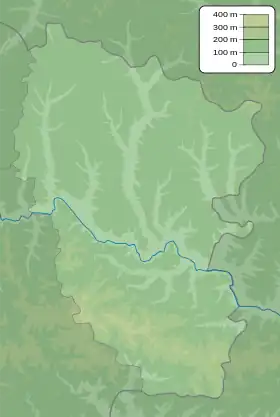
Luhansk Oblast is in far eastern Ukraine. Its north–south length is 250 km, and east–west width 190 km. It covers an area of 26,700 km2, 4.42% of the total area of Ukraine.
The oblast has the longest segment of Ukraine's international border with Russia among other regions (see State Border of Ukraine), consisting of 746 km (464 mi). The abutting Russian oblasts are Belgorod Oblast to the north, Voronezh Oblast to the northeast, Rostov Oblast to the east. Abutting Ukrainian oblasts are Kharkiv Oblast to the west, and Donetsk Oblast to the south.
The region is located in the valley of the Siversky Donets river, which flows west to east through the oblast and splits it approximately in half. The southern portion of the region is elevated by the Donetsk Ridge, which is close to the southern border. The highest point is Mohyla Mechetna (367 m (1,204 ft)), the highest point of Donetsk Ridge. The left bank of the Siversky Donets is part of the Starobilsk Plain. To the north this transforms into the Central Russian Upland.
History
Soviet Ukraine (1938–1991)
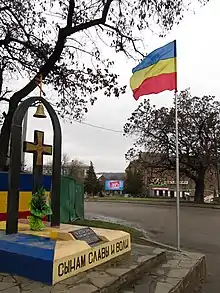
The oblast originated in 1938 as Voroshylovhrad (Russian: Voroshilovgrad) Oblast (Ukrainian: Ворошиловградська область, romanized: Voroshylovhradska oblast) after the Donetsk Oblast was split between Voroshylovhrad and Stalino (today Donetsk Oblast) oblasts. After the invasion by Nazi Germany in 1941, the region came under a German military administration, due to its proximity to frontlines. It was occupied at the end of 1942 as part of Case Blue German offensive directed towards Stalingrad.
Soon after the battle of Stalingrad, the Luhansk (at that time Voroshilovgrad in honor of Kliment Voroshilov) region again became the center of military operations during the Soviet counter-offensive operation Little Saturn in the spring of 1943. In the summer of 1943, the region was liberated from the Nazi Germany Armed Forces. During the Soviet era, the Oblast bore its current name between 1958 and 1970.
In the December 1991 referendum, 83.86% of votes in the oblast were in favor of the Declaration of Independence of Ukraine.
Pro-Russian insurgency (2014–2022)
On 8 April 2014, following the annexation of Crimea by Russia, pro-Russian separatists occupying the Luhansk Oblast administrative building planned to declare the independence of the region as the Luhansk Parliamentary Republic, after other pro-Russian separatists declared Donetsk People's Republic in the Donetsk Oblast (7 April 2014). When the Luhansk Parliamentary Republic ceased to exist, the separatists declared the Luhansk People's Republic on 27 April 2014. They held a disputed referendum on separating from Ukraine on 11 May 2014. The legitimacy of the referendums was not recognized by any government.[10] Ukraine does not recognize the referendum, while the EU and US said the polls were illegal and fraudulent.[11] Subsequently, the war in Donbas began.
As a result of the war in Donbas, Luhansk insurgents control the southern third of the oblast, which includes the city of Luhansk, the region's most populous city and the capital of the oblast. Due to this, most oblast government functions have moved to Sievierodonetsk, which forces of the Government of Ukraine recaptured in July 2014. Many universities located in the occupied areas have moved to government-controlled cities such as Sievierodonetsk, Starobilsk or Rubizhne.[12][13] A survey conducted in December 2014 by the Kyiv International Institute of Sociology found that 5.7% of the oblast's population supported their region joining Russia, 84.1% did not support the idea, and the rest were undecided or did not respond. Insurgent-controlled areas were not polled.[14]
Russian occupation (2022–present)
During the 2022 Russian invasion of Ukraine, Russian ground forces entered the occupied territory of Luhansk Oblast by crossing the Russian border on 22 February 2022. They invaded government-controlled territory across the line of contact and the Russian border on 24 February. As of 26 May 2022 they had occupied all but 5% of the region.[15]
During the mid-2022 battle of Donbas, Russian troops attacked and eventually captured the cities of Sieverodonetsk and Lysychansk during May and June 2022 in two of the most significant and most intense battles of the Eastern Ukraine offensive. By 3 July 2022, Russian and allied troops controlled all cities in the oblast. On 4–5 July 2022, during the international Ukraine Recovery Conference (URC 2022) in Lugano, Finland, Sweden, and the Czech Republic pledged to support the postwar rebuilding of the Luhansk region.[16] On 11 September 2022, there were unconfirmed reports that Bilohorivka near Lysychansk, was recaptured. On 19 September 2022, Ukrainian forces confirmed this.
In late September 2022 an annexation referendum was held in Luhansk on joining the Russian Federation, although Ukraine along with the United Nations and most observers declared the referendum to be illegitimate and fraudulent.[17] Following the staged victory in the voting, the region and the so-called Luhansk People's Republic were absorbed into Russia.[18] The United Nations General Assembly subsequently passed a resolution calling on countries not to recognise what it described as an "attempted illegal annexation" and demanded that Russia "immediately, completely and unconditionally withdraw".[19]
As of 5 October 2022, nearly all of the oblast is occupied by Russia, which claims the oblast as the Luhansk People's Republic (LPR), a self-declared state turned Russian federal subject. The war in Donbas and the subsequent 2022 Russian invasion of Ukraine saw heavy fighting in the oblast, with Sievierodonetsk captured in June by Russian and LPR forces[20] after an assault lasting several weeks,[21][22] and the oblast's last major settlement under Ukrainian control, Lysychansk, captured by Russian and Russia-backed forces on 2 July.[23] The next day, Russia's Minister of Defence announced that the entire territory of the oblast had been "liberated",[24] but three weeks later the governor of the oblast reported heavy fighting was still ongoing.[25] On 4 September, Ukrainian forces launched a counteroffensive in eastern Ukraine and recaptured small parts of Donetsk Oblast and, on 1 October, Lyman. Ukrainian forces also pushed through the stalemate at the Luhansk Oblast border and, most notably, recaptured Bilohirivka while engaging LPR forces in Lysychansk. Since then, there has been continued fighting in the western parts of the region in a renewed Luhansk Oblast campaign.
Administrative subdivisions
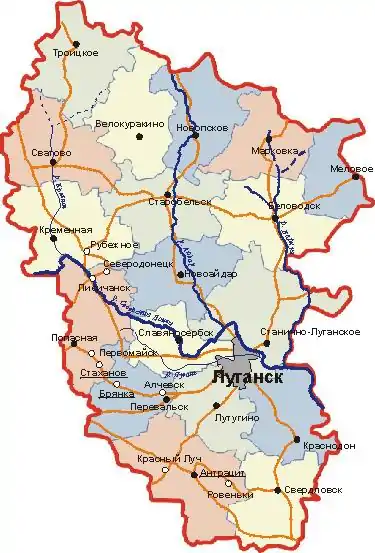
| English name | Local name | Type | Area (km2) | Population Census 2001 | Population estimate 1 Jan 2012 | Admin. center |
|---|---|---|---|---|---|---|
| Alchevsk | Алчевськ | city of regional significance | 49 | 119,193 | 112,071 | Alchevsk |
| Antratsyt | Антрацит | city of regional significance | 61 | 90,835 | 78,482 | Antratsit |
| Antratsitivsky | Антрацитівський (район) | raion | 1,662 | 36,971 | 31,454 | Antratsit |
| Bilokurakynsky | Білокуракинський (район) | raion | 1,436 | 23,807 | 19,858 | Bilokurakyne |
| Bilovodsky | Біловодський (район) | raion | 1,597 | 27,559 | 24,459 | Bilovodsk |
| Brianka | Брянка | city of regional significance | 64 | 61,357 | 54,085 | Brianca |
| Kadiivka | Кадіївка | city of regional significance | 92 | 108,266 | 92,818 | Kadiivka |
| Kirovsk | Кіровськ | city of regional significance | 35 | 45,012 | 36,708 | Kirovsk |
| Krasnodon | Краснодон | city of regional significance | 77 | 118,168 | 104,640 | Krasnodon |
| Krasnodonsky | Краснодонський (район) | raion | 1,386 | 32,846 | 29,983 | Krasnodon |
| Khrustalnyi | Красний Луч | city of regional significance | 154 | 145,129 | 125,166 | Khrustalnyi |
| Kreminsky | Кремінський (район) | raion | 1,627 | 51,927 | 42,357 | Kreminna |
| Luhansk | Луганськ | city of regional significance | 286 | 503,248 | 466,627 | Luhansk |
| Lutuhynsky | Лутугинський (район) | raion | 1,057 | 73,914 | 67,977 | Lutuhyne |
| Lysychansk | Лисичанськ | city of regional significance | 96 | 133,258 | 120,785 | Lysychansk |
| Markivsky | Марківський (район) | raion | 1,166 | 19,002 | 15,991 | Markivka |
| Milovsky | Міловський (район) | raion | 971 | 17,415 | 15,696 | Milove |
| Novoaidarsky | Новоайдарський (район) | raion | 1,536 | 28,451 | 25,618 | Novoaidar |
| Novopskovsky | Новопсковський (район) | raion | 1,623 | 38,322 | 35,271 | Novopskov |
| Perevalsky | Перевальський (район) | raion | 807 | 87,383 | 72,387 | Perevalsk |
| Pervomaisk | Первомайськ (Міськрада) | city of regional significance | 89 | 80,622 | 70,581 | Pervomaisk |
| Popasniansky | Попаснянський (район) | raion | 1,325 | 50,559 | 41,232 | Popasna |
| Rovenky | Ровеньки | city of regional significance | 217 | 91,712 | 84,366 | Rovenky |
| Rubizhne | Рубіжне | city of regional significance | 34 | 65,322 | 60,750 | Rubizhne |
| Sievierodonetsk | Северодонецьк | city of regional significance | 58 | 129,752 | 120,264 | Sieverodonetsk |
| Slovianoserbsky (raion) | Слов'яносербський (район) | raion | 1,113 | 62,125 | 55,462 | Slovianoserbsk |
| Stanychno-Luhansy | Станично-Луганський (район) | raion | 1,896 | 52,762 | 49,732 | Stanychno-Luhanske |
| Starobilsky | Старобільський (район) | raion | 1,582 | 57,755 | 47,765 | Starobilsk |
| Svativsky | Сватівський (район) | raion | 1,739 | 43,069 | 37,652 | Svatove |
| Sverdlovsk | Свердловськ | city of regional significance | 84 | 110,159 | 99,024 | Sverdlovsk |
| Sverdlovsky | Свердловський (район) | raion | 1,132 | 14,574 | 12,210 | Sverdlovsk |
| Troitsky | Троїцький (район) | raion | 1,633 | 25,704 | 21,205 | Troitske |
| Oblast total | Луганська (Область) | oblast | 26,683 | 2,546,178 | 2,272,676 | Luhansk |
Like the other provinces of Ukraine, Luhansk Oblast has a double jurisdiction. The oblast is predominantly administrated by the Luhansk Oblast State Administration, headed by the governor of the oblast, who is appointed by the President of Ukraine. The province has a representative body, the provincial council, which is headed by its chairman and elected by popular vote.
The province is primarily divided into 18 raions (districts), and 37 cities, including 14 cities of regional significance. The administrative center is Luhansk. These raions are listed below with their areas and populations.[26]
The province's secondary division consists of various municipalities. Those municipalities may consist of one or more populated places. The municipalities are administratively subordinate to the raion in which they are located, with the exception of 14 cities subordinated directly to the oblast. The city of Luhansk is subdivided into its own four city-districts (boroughs).
All subdivisions are governed by their respective councils (radas).
Cities
Largest cities or towns in Luhansk Oblast Source? | |||||||||
|---|---|---|---|---|---|---|---|---|---|
| Rank | Raion | Pop. | |||||||
 Luhansk 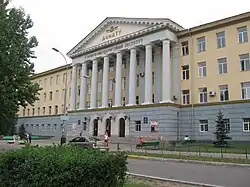 Alchevsk |
1 | Luhansk | Luhansk* | 425,848 |  Sievierodonetsk  Lysychansk | ||||
| 2 | Alchevsk | Alchevsk* | 114,624 | ||||||
| 3 | Sievierodonetsk | Sievierodonetsk* | 121,000 | ||||||
| 4 | Lysychansk | Lysychansk* | 103 459 | ||||||
| 5 | Khrustalnyi | Khrustalnyi* | 82,765 | ||||||
| 6 | Kadiivka | Kadiivka* | 76,492 | ||||||
| 7 | Sverdlovsk | Sverdlovsk* | 64,503 | ||||||
| 8 | Rubizhne | Rubizhne* | 63,474 | ||||||
| 9 | Antratsyt | Antratsyt* | 54,640 | ||||||
| 10 | Rovenky | Rovenky* | 47,852 | ||||||
Demographics
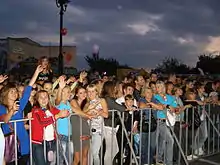
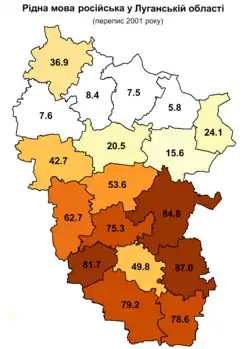
The population is largely Russian-speaking, although ethnic Ukrainians constitute a majority (58.0%). Among the minorities are native Russians (39.1%), Belarusians (0.8%), and others (1.4%). Ukrainians constitute the majority in all raions except for Stanytsia-Luhanska Raion and Krasnodon Raion, both of which are east of Luhansk. Ethnic Russians also constitute the majority in regionally significant cities, such as Krasnodon, Sverdlovsk, Khrustalnyi and Kadiivka.
In the 2001 Ukrainian Census, more than 68.8% of the population considered themselves Russian speakers, while 30.0% considered themselves Ukrainian speakers. The Russophone population predominates in the southern portion of the region and around the city of Luhansk, while the northern region is less populated, mostly agricultural and Ukrainophone.
Its population (as of 2004) of 2,461,506 constitutes 5.13% of the overall Ukrainian population. The Luhansk Oblast rates fifth in Ukraine by the number of its inhabitants, having an average population density of 90.28/km2. About 87% of the population lives in urban areas, while the remaining 13% reside in agricultural areas. According to the national census, 54% of the population are Ukrainians and 42% are Russians.
Age structure
- 0–14 years: 12.3%
 (male 143,272/female 134,803)
(male 143,272/female 134,803) - 15–64 years: 71.4%
 (male 768,544/female 838,639)
(male 768,544/female 838,639) - 65 years and over: 16.3%
 (male 117,782/female 248,914) (2013 official)
(male 117,782/female 248,914) (2013 official)
Median age
- total: 42.1 years

- male: 38.2 years

- female: 45.9 years
 (2013 official)
(2013 official)
Economy
Economically the region is connected with the Donets Basin.
Extractive industry
- Lysychansk Coal
- Luhansk Coal
- Sverdlov Anthracite
- Anthracite
- Pervomaisk Coal
- Rovenky Anthracite
- Donbas Anthracite
Machine building
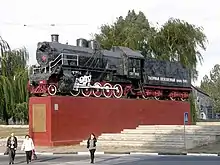
- Luhanskteplovoz
- Khrustalnyi Machine building Factory
- Pervomaisk Power mechanical Factory
- Stakhanov Railcar Plant
Metallurgy
Chemicals and oil refining
- Sievierodonetsk Association Azot
- Association Skloplastyk
- Lysynchansk Oil Refinery
Agriculture
The oblast has post industrial sites which run off building material into surrounding land. Yakymchuk 2018 finds feral stands of Triticum aestivum have colonised several of these sites.[27]
Power generation
- Sievierodonetsk Power Station
- Luhansk power station
- Shteriv power station (decommissioned in 1983)
Transport
Through the region pass two major European routes ![]() E50 and
E50 and ![]() E40. There are 24 Russo-Ukrainian international border checkpoints of various entry.
E40. There are 24 Russo-Ukrainian international border checkpoints of various entry.
 E50 within the Luhansk Oblast uses highway
E50 within the Luhansk Oblast uses highway  M 03 that starts from Debaltseve (Donetsk Oblast), passes through the city of Khrustalnyi, and enters the Russian Federation at the border checkpoint "Dovzhansky" (settlement Dovzhanske, town of Biryukove).
M 03 that starts from Debaltseve (Donetsk Oblast), passes through the city of Khrustalnyi, and enters the Russian Federation at the border checkpoint "Dovzhansky" (settlement Dovzhanske, town of Biryukove). E40 within the Luhansk Oblast uses highway
E40 within the Luhansk Oblast uses highway  M 04 that starts from Debaltseve (Donetsk Oblast), passes through the city of Luhansk, and enters the Russian Federation at the border checkpoint "Izvaryne" (town of Izvaryne).
M 04 that starts from Debaltseve (Donetsk Oblast), passes through the city of Luhansk, and enters the Russian Federation at the border checkpoint "Izvaryne" (town of Izvaryne).- There is also another highway
 H 21 that runs from north to south and connects Starobilsk, Luhansk, and Khrustalnyi with Donetsk.
H 21 that runs from north to south and connects Starobilsk, Luhansk, and Khrustalnyi with Donetsk.
Rail transportation is administered by the Donetsk Railway.
There is also its regional airport Luhansk International Airport with its own carrier.
Education
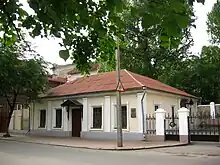
Specialized
- Luhansk State Medical University
- Luhansk National Agrarian University
- Luhansk State University of Internal Affairs
Points of interest
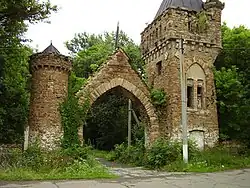
The following sites were nominated for the Seven Wonders of Ukraine.
- The house of Dal's birth (Luhansk)
- Fighters for the Revolution monument
- Derkul horse factory
- Royal Rocks (Luhansk State Preserve)
- Chasm Steppe (Sverdlovsk Raion)
- Ram Foreheads (limestone rocks)
- Mścichowski Palace (Палац Мсциховського)
Notable people
- Oleksiy Danilov (born 1962), Ukrainian politician
- Dov Markus (born 1946), Israeli-American soccer player, born in Ukraine.
- Serhiy Zhadan (born 1974), writer.
See also
References
- Oda, UA: LG, 2007, archived from the original on 5 August 2008.
- Umoloda, Kyiv, UA.
- Oda, UA: LG, 1930, archived from the original on 24 May 2011.
- "Territory", 70 years, UA: LG, 14 March 2008 [1977], archived from the original on 24 May 2011, retrieved 17 September 2008.
- "70 years", Calendar, UA: LG, 11 April 2008, archived from the original on 24 May 2011, retrieved 17 September 2008.
- Чисельність наявного населення України на 1 січня 2022 [Number of Present Population of Ukraine, as of January 1, 2022] (PDF) (in Ukrainian and English). Kyiv: State Statistics Service of Ukraine. Archived (PDF) from the original on 4 July 2022.
- "Валовии регіональнии продукт".
- Про внесення змін і доповнень до Конституції (Основного Закону) Української РСР | від 19.06.1991 № 1213а-XII
- "Russia-Ukraine war live: Ukrainian forces reportedly take control of Piatykhatky – as it happened". The Guardian. 18 June 2023. Retrieved 18 June 2023.
- "Ukraine's Eastern Region Of Luhansk May Now Hold Referendum On Joining Russia". Business Insider. Retrieved 12 May 2014.
- BBC News 12 May 2014
- "In Severodonetsk, Petro Poroshenko presented Luhansk RSA Head Hennadiy Moskal – Official web-site of President of Ukraine". Archived from the original on 18 March 2015. Retrieved 21 January 2015.
- "Lugansk University. Location, phone, address, contacts". luganskukraine.info. Archived from the original on 7 August 2016. Retrieved 16 October 2014.
- Лише 3% українців хочуть приєднання їх області до Росії [Only 3% of Ukrainians want their region to become part of Russia]. Dzerkalo Tyzhnia (in Ukrainian). 3 January 2015.
- "Russian forces have 'upper hand' in Donbas fighting, Ukrainian officials say". the Guardian. 26 May 2022. Retrieved 27 May 2022.
- "Провідні країни Європи відбудовуватимуть Україну, – Гайдай". LB.ua. 5 July 2022. Retrieved 11 July 2022.
- "So-called referenda in Russian-controlled Ukraine 'cannot be regarded as legal': UN political affairs chief". 27 September 2022.
- Trevelyan, Mark (30 September 2022). "Putin signs treaties to annex Ukrainian lands". Reuters. Retrieved 30 September 2022.
- "Ukraine: UN General Assembly demands Russia reverse course on 'attempted illegal annexation'". 12 October 2022.
- Balmforth, Tom; Djurica, Marko (25 June 2022). "Sievierodonetsk falls to Russia after one of war's bloodiest fights". Reuters. Retrieved 25 June 2022.
- "Ukrainian troops told to leave Severodonetsk: governor". PolskieRadio.pl. Retrieved 24 June 2022.
- "Ukrainians Retreat From Key Areas Of Eastern Region As Fighting Enters Fifth Month". Radiofreeeurope/Radioliberty. Retrieved 24 June 2022.
- "Institute for the Study of War". Institute for the Study of War. Retrieved 3 July 2022.
- Balmforth, Tom; Hunder, Max (3 July 2022). "Zelenskiy vows to regain Lysychansk after Ukrainian withdrawal". Reuters. Retrieved 4 July 2022.
- Roshchina, Olena (25 July 2022). "Russian forces attempt to advance to Luhansk Oblasts administrative borders from 3 directions but retreated". news.yahoo.com. Retrieved 26 July 2022.
- State Statistics Committee of Ukraine, Kyiv.
- Kobetičová, Klára; Černý, Robert (2019). "Terrestrial eutrophication of building materials and buildings: An emerging topic in environmental studies". Science of the Total Environment. Elsevier. 689: 1316–1328. Bibcode:2019ScTEn.689.1316K. doi:10.1016/j.scitotenv.2019.06.423. ISSN 0048-9697. PMID 31466168. S2CID 198365229.
External links
- Official site of Luhansk Oblast Administration (in Ukrainian)
- Information Card of the Region – official site of the Cabinet of Ministers of Ukraine
